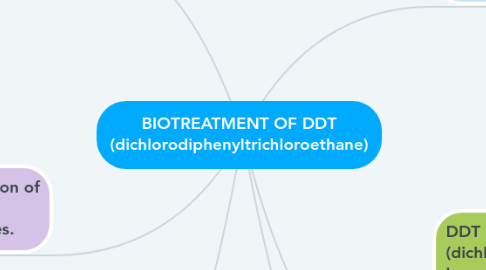BIOTREATMENT OF DDT (dichlorodiphenyltrichloroethane)
by Lorena Morales

1. Pesticide Degradation Through White Wood Rot Fungi
1.1. Biodegradation has reached values between 30 and 90%,
1.2. The use of white rot fungi has shown the great potential they have for the biodegradation of a wide spectrum of xenobiotics such as chemical insecticides
1.3. Three main enzymatic mechanisms are known that are used by wood rot fungi to degrade environmental pollutants, two oxidative and one reductive: i) lignin degradation system. ii) phase I of metabolism, oxidative mechanism involving the enzymes cytochrome P-450 monooxygenases iii) phase II of metabolism where a set of enzymes catalyzes conjugation reactions reducing pollutants
2. Biodegradation of DDT by two native strains of white rot fungi
2.1. Two strains of White Rot Fungi are used, Ganoderma zonatum B-18 and Trametes maxima MUCL 44155. The strains were conserved in sterile distilled water at 4º C
2.2. The strains Trametes maxima (MUCL 44155) and Ganoderma zonatum (B-18) showed a high biodegradation capacity over DDT (99% and 73% degradation, respectively), only detecting the presence of intermediate metabolites in G. zonatum cultures. from Degradation.
3. Stimulated biodegradation of soils contaminated with organochlorine pesticides.
3.1. The microbiological analysis of the soil allowed to identify the native strains, highlighting the genera of Burkholderias cepacia, Pseudomonas (fluorescens, putida, mendocina), and Aeromonas caviae, as bacteria with high degradative potential of organochlorine compounds.
3.2. After 8 weeks of anaerobic treatment, the bioaugmentation process stood out, in which 56.48% of the 4.4'-DDT removed was presented.
4. DDT (dichlorodiphenyltrichloroethane) is a long-acting, stable, broad-spectrum, synthetic organochlorine pesticide, used extensively in the past to control insects on agricultural crops and insects carrying diseases such as malaria and typhus.
5. DDT, DDE, and DDD stay in the soil for a long time, possibly hundreds of years. Most DDT breaks down slowly to DDE and DDD, usually by the action of microorganisms.
6. DDT, DDE, and DDD stay in the soil for a long time, possibly hundreds of years


